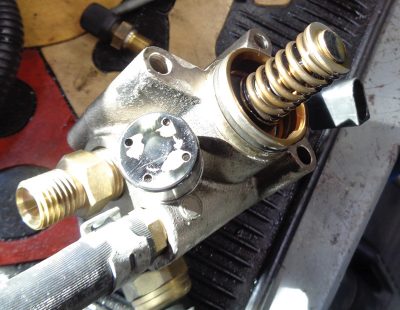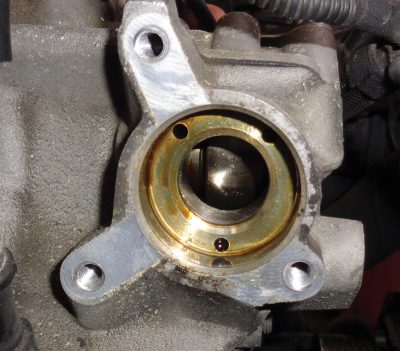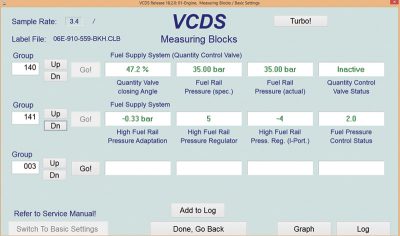With increasing fuel economy standards, modern Audis include technologies to increase fuel efficiency and power. This begins with the fuel supply system, as it directly affects vehicle driving dynamics and efficiency.
Almost every auto manufacturer has moved to high pressure fuel systems with direct injection. As this technology is fine tuned, many small issues are being ironed out to increase reliability.

Direct injection is an evolution of the port injection fuel system. Instead of injecting fuel down the intake tract and then into the combustion chamber, fuel injectors have been relocated to spray directly into the combustion chamber. This allows vehicle engineers to finely tune injection amounts, providing much more control for consistent fuel atomization. All of this leads to higher power output and increased fuel economy.
In addition to different fuel injector locations, the direct injection fuel system must operate at a much higher pressure than previous port-injected engines. The higher injection pressure ensures a consistent ideal fuel atomization during the injection process. One thing you may notice on a direct injected Audi is the noise created by fuel injectors firing off. They are quite loud, and at idle, to the untrained ear, the sound may be described as excessive valve train noise.
Safety Considerations
One thing to keep in mind when working on any high pressure fuel system is safety. These systems operate at a much higher pressure than old school low pressure fuel supply systems. Instead of operating fuel pressures of 50 psi or 3.5 bar, modern Audi fuel systems operate at pressures up 2,500 psi or 172 bar! This pressure can be extremely dangerous if proper safety procedures are not followed when making repairs.
One example of this is fuel injector seals. Even slight damage to seal rings can allow fuel leakage, which can cause many issues, finely vaporized fuel spray in the engine bay being the most dangerous. Always replace fuel injector seals on the high pressure fuel supply system if injectors have been disturbed.
Because the vehicles do not have test ports for high pressure fuel systems, a fuel pressure gauge is not used to diagnose the high pressure side of the fuel system. No company currently offers fuel pressure gauges that can withstand the extreme high pressure involved in direct injection fuel pressure. Generally, the only way to monitor high side fuel pressure is through scanning equipment.
It is still possible to monitor low side fuel pressure on Audi vehicles by placing a gauge inline on the low side fuel inlet line. Unfortunately, most modern Audis do not have a simple Schraeder style valve with which to monitor fuel pressure because of packaging and emissions constraints.

Through an electric in-tank fuel pump, fuel pressure is supplied to the high pressure pump at the engine. All modern Audi vehicles use a demand controlled supply system. This monitors fuel demand and adjusts the low side pressure to accommodate fuel needs. The low side fuel pressure is generally around 50–80 psi. On most Audi vehicles, this is controlled by a separate fuel pump control unit. By using a PWM (Pulse Width Modulated signal), the control unit can monitor and vary fuel pressure delivery as needed.
If you suspect a bad in-tank fuel pump, don’t forget about the fuel pump control unit that directly controls the pump. It’s often located in underbody areas of the vehicle, which can be exposed to water ingress and even rodent wiring damage. If the control unit has failed, it will not power up the in-tank fuel pump. Don’t forget the basics, and always check power and ground connections at both the pump and control unit.

During the diagnostic process, it’s possible to monitor the fuel pump adaptation values. This monitors the load required for the fuel pump to deliver appropriate fuel pressure. On vehicles with a weak in-tank pump or clogged filter, the adaptation values will be very high even at idle. A vehicle showing upwards of 50 percent adaptation value at idle is definitely having supply issues. If the vehicle is found to have a bad in-tank fuel pump, it’s always wise to recommend replacing the control unit at the same time. After replacement, it’s necessary to run adaptation on the new fuel pump. This will reset and relearn operating parameters on the new pump.
Driving a vehicle constantly on low fuel levels eventually damages the in-tank fuel pump. These pumps use fuel to cool and lubricate the pump during operation. Without the cooling effect of being bathed in fuel, eventually the pump motors seize or become weak. Keep this in mind when diagnosing fuel supply problems.
Even ethanol content can negatively affect the in-tank pumps. Ethanol is known to rapidly absorb any moisture present in the fuel. Once absorbed, the water-heavy ethanol settles to the bottom of the fuel tank. On vehicles that are parked for extended periods of time, this wreaks havoc on the fuel pump. It’s not uncommon to see a rusty seized in-tank pump caused by high ethanol content gasoline.

Ethanol content in gas varies widely depending on where you fill the vehicle. All modern Audi vehicles are designed to operate on at least 10 percent ethanol content gas. Unfortunateley, many fuel suppliers have much higher ethanol content without labeling it as such. It’s not uncommon to see ethanol content between 15 and 25 percent, even on regular pump gas. This can be a problem on vehicles not designed for such high ethanol content. By volume, the energy content in ethanol is 30 percent less than regular gasoline. This means you need to burn more to go the same distance, ultimately delivering fewer miles per gallon.
Audi vehicles are able to monitor ethanol percentage in the gasoline and adapt engine parameters to a certain degree. Often there is a measuring block available to monitor ethanol percentage. This is much easier than taking a fuel sample and testing for ethanol content. If levels are too high, the engine will retard ignition timing, resulting in low power and rough running conditions. Unless the Audi is e85 rated, anything higher than 15 percent ethanol can cause issues.

Audi fuel systems rely on relatively few sensors to monitor fuel pressure. To monitor low side pressure a sensor is usually mounted to the high pressure fuel pump assembly. If the low side sensor fails, it will store faults. One common fault code stored for the fuel supply system is a P310B low pressure fuel regulation: Fuel regulation outside specification. To monitor the high side fuel pressure, a sensor is mounted to the high pressure fuel rail. This is often called a thrust sensor or high pressure sensor (G247). These sensors have a high failure rate and can be difficult to diagnose accurately if fault codes have not set. Often, the sensor reads too high fuel pressure, resulting in a rich mixture. A failed G247 puts the engine in fail-safe mode, relying on a predetermined low pressure running mode.
The high pressure fuel pump is the true workhorse of the fuel supply system on Audi vehicles. These are all mechanically driven by a camshaft or, for the vr6 engine, a secondary lobe running off the timing chain setup. These have relatively few moving parts but live a very difficult life. Many technicians are familiar with high-pressure pump failure, as such failures are common.
On earlier 2.0t engines, it was not uncommon for the high pressure pump to completely wear through the cam follower. Surprisingly, the vehicle usually does not show any obvious signs of cam follower failure until it’s too late. If left unchecked, the pump continues to wear out the lobe on the camshaft that’s meant to operate the pump. This repair can be quite extensive as the camshaft, high-pressure pump, and cam follower all must be replaced.

Less common to fail is the fuel pressure regulator valve (N276) on the high pressure pump. If the regulator valve has failed, a fault code will generally be stored and the vehicle will run in limp mode, relying strictly on low side fuel pressure to run the vehicle.
This can be audibly noted, as the fuel injectors will not be clicking loudly during operation. If the regulator valve has failed, it is not serviceable. A new high pressure pump must be fitted. Always replace the cam follower during high pressure pump replacement. The follower may not appear to be worn but will wear through surface hardening during use.
Always follow proper safety procedures when working on Audi fuel systems. Fuel vapor can be extremely dangerous when being released, particularly with high-pressure fuel systems.
Download PDF







0 Comments